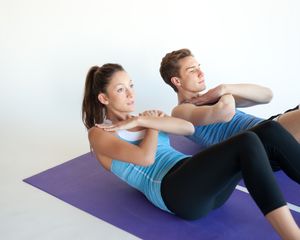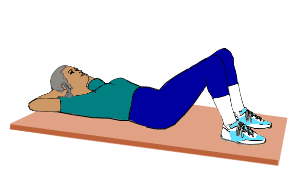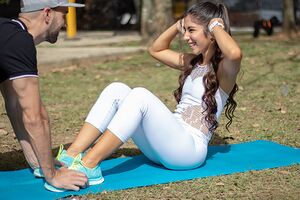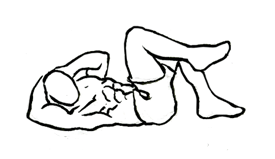Curl-ups: Difference between revisions
No edit summary |
No edit summary |
||
| (15 intermediate revisions by 3 users not shown) | |||
| Line 2: | Line 2: | ||
'''Original Editor '''- [[User:Lilian Ashaf|Lilian Ashraf]] | '''Original Editor '''- [[User:Lilian Ashaf|Lilian Ashraf]] | ||
'''Top Contributors''' - {{Special:Contributors/{{FULLPAGENAME}}}} | '''Top Contributors''' - {{Special:Contributors/{{FULLPAGENAME}}}} | ||
</div> | </div> | ||
== | == Introduction == | ||
[[File:Curl-up.jpg|curl-up exercise |alt=|right|frameless]] | |||
The curl-up exercise is one of the most common [[Exercises for Lumbar Instability|exercises]] that target the [[Abdominal Muscles|abdominal muscle]]<nowiki/>s. The curl up exercise works on the endurance of the abdominals, important in [[Lumbar|back]] support and [[Core Stability|core stability]].<ref name=":5">Top end sports [https://www.topendsports.com/testing/tests/abendur.htm Curl up] Available: https://www.topendsports.com/testing/tests/abendur.htm<nowiki/>(accessed 3.1.2022)</ref> Having abdominal muscles with high [[Endurance Exercise|endurance]] helps prevent [[Low Back Pain|low-back pain]].<ref name=":3" /> | |||
The curl-up requires use of the abdominal muscles to curl the upper body off the floor. It requires only a partial sit up and hence the [[hip]] flexors ([[Iliopsoas Tendinopathy|iliopsoas]] is the strongest hip flexor) do not participate in the movement. Research has shown that in a full sit up the hip flexors do most of the work<ref name=":3">AZ central What Does the Curl Ups Test Measure?Available:https://healthyliving.azcentral.com/curl-ups-test-measure-10744.html (accessed 3.1.2022)</ref>. | |||
== | == Muscles Targeted == | ||
The | [[File:Abdominal curl-CDC strength training for older adults.gif|right|frameless]] | ||
The curl-up mainly activates the [[Abdominal Muscles|rectus abdominis]], [[External Abdominal Oblique|external oblique]], [[Internal Abdominal Oblique|internal oblique]] and [[Transversus Abdominis|transversus abdominis]]. Different curl-ups angles affect the abdominal muscles activity.<ref name=":0">Ha SY, Shin DC. The effects of curl-up exercise in terms of posture and muscle contraction direction on muscle activity and thickness of trunk muscles. Journal of Back and Musculoskeletal Rehabilitation. 2020 Feb 28(Preprint):1-7.</ref> | |||
* Maximum activity of the abdominal muscles occurs at 30 degrees eccentric curl-up angle, which is achieved by lifting only the shoulders from the floor. | |||
* The activity of the abdominal muscles decrease as the curl-up angle increase (moving the body towards the vertical position) due to decrease in the body resistance torque. | |||
* The transverses abdominis muscle acts as a corset contributing to the inter-segmental control of the lumbar spine, rather than contributing in trunk flexion<ref name=":0" />. | |||
'''Image 2:''' The hands are incorrectly placed in this image, having hands behind the head encourages the subject to stress the neck and pull the head forward<ref name=":4">Sports performance bulletin Abdominal strength training – the curl-up Available:https://www.sportsperformancebulletin.com/endurance-training/strength-conditioning-and-flexibility/abdominal-strength-training-curl/ (accessed 3.1.2022)</ref>. | |||
== | == Technique == | ||
*[[File:Curl up.jpeg|right|frameless]]Start in supine with with [[Knee|knees]] bent and feet comfortably flat on the floor; | |||
* Adjust the [[Pelvic Tilt|pelvis]] so that the lumbar spine is in the neutral position. | |||
* Curl up your head and bring your chin towards your chest, fixing your neck position (as if you were holding an tennis ball between your chin and neck) | |||
* Hands placed behind ears with elbows pointing out to the side. | |||
* Focus on abdominals, curling upper back off the floor, not moving any other body part, keeping arms, shoulders, neck and legs relaxed as the abs pull you up. If the movement is performed correctly, the head and arms will curl up as one unit with your shoulders; | |||
* Stop when the upper back is off the floor. | |||
* Pause for one count at the top. | |||
* Slowly lower the upper back down to the floor<ref name=":4" /> | |||
Perform the exercise an optimal speed that allows both maximum activation of the abdominal muscles and adequate motor control. Barbado et al.(2015) concluded that: | |||
# For active individuals the fastest cadence is 1 repetition/1 s that could be used, | |||
# For other less active populations a slower curl-up speed is recommended to decrease the risk of injury and allow for motor control.<ref name=":2">Barbado D, Elvira JL, Moreno FJ, Vera-Garcia FJ. [https://www.ncbi.nlm.nih.gov/pmc/articles/PMC4519219/ Effect of performance speed on trunk movement control during the curl-up exercise.] Journal of human kinetics. 2015 Jun 1;46(1):29-37.</ref> | |||
[[File:Cross-body-crunch-2.png|right|frameless]] | |||
Variations: Bicycle Crunch and '''Cross Crunches (Image 4)'''<ref>Exercise.com.au [https://www.exercises.com.au/curl-up/ Curl ups] Available: https://www.exercises.com.au/curl-up/<nowiki/>(accessed 3.1.2022)</ref> | |||
Avoiding over-stressing the spinal tissues | |||
* Do not exceed 60 repetitions of curl ups. | |||
* For untrained individuals the training should start with a low volume 2 sets of 15 repetitions then progressively increase. | |||
* A minimum of 48 hour to 72 hour rest should be allocated between dynamic spinal flexion exercise to allow the spinal tissue, muscles and [[Intervertebral disc|intervertebral discs]] to remodel. | |||
* Spinal flexion exercise shouldn’t be done until 1 hour of waking up, to decrease the risk of injury.<ref name=":1">Contreras B, Schoenfeld B. [https://journals.lww.com/nsca-scj/Fulltext/2011/08000/To_Crunch_or_Not_to_Crunch__An_Evidence_Based.2.aspx To crunch or not to crunch: An evidence-based examination of spinal flexion exercises, their potential risks, and their applicability to program design.] Strength & Conditioning Journal. 2011 Aug 1;33(4):8-18.</ref> | |||
== Curl Up Test == | |||
A common method of performing a sit-up fitness test is to record the maximum number of sit ups in a certain time period, eg 30 seconds, one minute or two minutes. Alternatively, the test may be performed at a set tempo, and the maximum number of total sit-ups is recorded. | |||
The completion of one complete curl-up (up and back) counts as one. The sit-up must be performed correctly for it to be counted. For the tempo tests, the test is continued until the subject cannot maintain the rhythm or has reached the target number for the test.<ref name=":5" /> | |||
<br> | Below are normative values can be used as a guide. Alternatively you can simply record the clients initial test result and use this to show progress against in future tests. | ||
{| class="wikitable" | |||
|'''Fitness category''' | |||
|'''Males''' | |||
|'''Females''' | |||
|- | |||
|Excellent | |||
|>32 | |||
|>25 | |||
|- | |||
|Satisfactory | |||
|25 – 32 | |||
|15 – 25 | |||
|- | |||
|Needs improvement | |||
|<25 | |||
|<15 | |||
|} | |||
<ref>PT direct. [https://www.ptdirect.com/training-delivery/client-assessment/abdominal-curl-test-a-muscular-strength-endurance-test-of-the-abdominal-muscles Abdominal curl test] Available:https://www.ptdirect.com/training-delivery/client-assessment/abdominal-curl-test-a-muscular-strength-endurance-test-of-the-abdominal-muscles (accessed 3.1.2022)</ref> <br> | |||
== References == | == References == | ||
<references /> | <references /> | ||
[[Category:Exercise Therapy]] | |||
[[Category:Physical Activity]] | |||
[[Category:Interventions]] | |||
[[Category:Thoracic Spine - Interventions]] | |||
[[Category:Outcome Measures]] | |||
Latest revision as of 05:38, 3 January 2022
Original Editor - Lilian Ashraf
Top Contributors - Lucinda hampton, Sheik Abdul Khadir, Lilian Ashraf, Daan Vandebriel and Wanda van Niekerk
Introduction[edit | edit source]
The curl-up exercise is one of the most common exercises that target the abdominal muscles. The curl up exercise works on the endurance of the abdominals, important in back support and core stability.[1] Having abdominal muscles with high endurance helps prevent low-back pain.[2]
The curl-up requires use of the abdominal muscles to curl the upper body off the floor. It requires only a partial sit up and hence the hip flexors (iliopsoas is the strongest hip flexor) do not participate in the movement. Research has shown that in a full sit up the hip flexors do most of the work[2].
Muscles Targeted[edit | edit source]
The curl-up mainly activates the rectus abdominis, external oblique, internal oblique and transversus abdominis. Different curl-ups angles affect the abdominal muscles activity.[3]
- Maximum activity of the abdominal muscles occurs at 30 degrees eccentric curl-up angle, which is achieved by lifting only the shoulders from the floor.
- The activity of the abdominal muscles decrease as the curl-up angle increase (moving the body towards the vertical position) due to decrease in the body resistance torque.
- The transverses abdominis muscle acts as a corset contributing to the inter-segmental control of the lumbar spine, rather than contributing in trunk flexion[3].
Image 2: The hands are incorrectly placed in this image, having hands behind the head encourages the subject to stress the neck and pull the head forward[4].
Technique[edit | edit source]
- Start in supine with with knees bent and feet comfortably flat on the floor;
- Adjust the pelvis so that the lumbar spine is in the neutral position.
- Curl up your head and bring your chin towards your chest, fixing your neck position (as if you were holding an tennis ball between your chin and neck)
- Hands placed behind ears with elbows pointing out to the side.
- Focus on abdominals, curling upper back off the floor, not moving any other body part, keeping arms, shoulders, neck and legs relaxed as the abs pull you up. If the movement is performed correctly, the head and arms will curl up as one unit with your shoulders;
- Stop when the upper back is off the floor.
- Pause for one count at the top.
- Slowly lower the upper back down to the floor[4]
Perform the exercise an optimal speed that allows both maximum activation of the abdominal muscles and adequate motor control. Barbado et al.(2015) concluded that:
- For active individuals the fastest cadence is 1 repetition/1 s that could be used,
- For other less active populations a slower curl-up speed is recommended to decrease the risk of injury and allow for motor control.[5]
Variations: Bicycle Crunch and Cross Crunches (Image 4)[6]
Avoiding over-stressing the spinal tissues
- Do not exceed 60 repetitions of curl ups.
- For untrained individuals the training should start with a low volume 2 sets of 15 repetitions then progressively increase.
- A minimum of 48 hour to 72 hour rest should be allocated between dynamic spinal flexion exercise to allow the spinal tissue, muscles and intervertebral discs to remodel.
- Spinal flexion exercise shouldn’t be done until 1 hour of waking up, to decrease the risk of injury.[7]
Curl Up Test[edit | edit source]
A common method of performing a sit-up fitness test is to record the maximum number of sit ups in a certain time period, eg 30 seconds, one minute or two minutes. Alternatively, the test may be performed at a set tempo, and the maximum number of total sit-ups is recorded.
The completion of one complete curl-up (up and back) counts as one. The sit-up must be performed correctly for it to be counted. For the tempo tests, the test is continued until the subject cannot maintain the rhythm or has reached the target number for the test.[1]
Below are normative values can be used as a guide. Alternatively you can simply record the clients initial test result and use this to show progress against in future tests.
| Fitness category | Males | Females |
| Excellent | >32 | >25 |
| Satisfactory | 25 – 32 | 15 – 25 |
| Needs improvement | <25 | <15 |
References[edit | edit source]
- ↑ 1.0 1.1 Top end sports Curl up Available: https://www.topendsports.com/testing/tests/abendur.htm(accessed 3.1.2022)
- ↑ 2.0 2.1 AZ central What Does the Curl Ups Test Measure?Available:https://healthyliving.azcentral.com/curl-ups-test-measure-10744.html (accessed 3.1.2022)
- ↑ 3.0 3.1 Ha SY, Shin DC. The effects of curl-up exercise in terms of posture and muscle contraction direction on muscle activity and thickness of trunk muscles. Journal of Back and Musculoskeletal Rehabilitation. 2020 Feb 28(Preprint):1-7.
- ↑ 4.0 4.1 Sports performance bulletin Abdominal strength training – the curl-up Available:https://www.sportsperformancebulletin.com/endurance-training/strength-conditioning-and-flexibility/abdominal-strength-training-curl/ (accessed 3.1.2022)
- ↑ Barbado D, Elvira JL, Moreno FJ, Vera-Garcia FJ. Effect of performance speed on trunk movement control during the curl-up exercise. Journal of human kinetics. 2015 Jun 1;46(1):29-37.
- ↑ Exercise.com.au Curl ups Available: https://www.exercises.com.au/curl-up/(accessed 3.1.2022)
- ↑ Contreras B, Schoenfeld B. To crunch or not to crunch: An evidence-based examination of spinal flexion exercises, their potential risks, and their applicability to program design. Strength & Conditioning Journal. 2011 Aug 1;33(4):8-18.
- ↑ PT direct. Abdominal curl test Available:https://www.ptdirect.com/training-delivery/client-assessment/abdominal-curl-test-a-muscular-strength-endurance-test-of-the-abdominal-muscles (accessed 3.1.2022)










